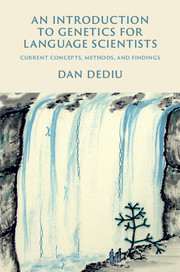Book contents
- Frontmatter
- Dedication
- Contents
- List of illustrations
- Acknowledgements
- 1 Introduction
- 2 Nature, nurture, and heritability
- 3 The molecular bases of genetics
- 4 Effects of genes on phenotype
- 5 Linkage disequilibrium and its role in finding genes
- 6 What do genes actually do?
- 7 The way forward: exome and genome sequencing
- 8 Population and evolutionary genetics
- 9 Interactions between genetic and cultural evolution
- 10 Conclusions, topics not covered, future directions
- Appendix The computer code
- References
- Index
- Glossary
10 - Conclusions, topics not covered, future directions
Published online by Cambridge University Press: 05 April 2015
- Frontmatter
- Dedication
- Contents
- List of illustrations
- Acknowledgements
- 1 Introduction
- 2 Nature, nurture, and heritability
- 3 The molecular bases of genetics
- 4 Effects of genes on phenotype
- 5 Linkage disequilibrium and its role in finding genes
- 6 What do genes actually do?
- 7 The way forward: exome and genome sequencing
- 8 Population and evolutionary genetics
- 9 Interactions between genetic and cultural evolution
- 10 Conclusions, topics not covered, future directions
- Appendix The computer code
- References
- Index
- Glossary
Summary
This book is intended to give a relatively up-to-date introduction and overview tailored to the needs of speech and language scientists who venture into genetics and do not have the time to delve into more comprehensive general introductions such as Brown and Brown (2012), Snustad and Simmons (2010) and Jobling et al. (2013). It tries to cover selected topics using wherever possible examples from speech and language and tries to give a level of understanding that should be enough for working in cross-disciplinary teams and understanding modern genetic and genomic research. The book tries to refer both to up-to-date reviews and to primary research reports, which should allow the reader to deepen his or her understanding on selected topics or to understand alternative or emerging interpretations and views.
The main aim of the book, if one must be singled out at all costs, is to allow language and speech scientists to appreciate the complexity and beauty of their topic of interest's genetic infrastructure and understand the constraints and opportunities such an understanding has on their day-to-day work, be it designing psycholinguistic experiments into the acquisition of non-native phonological contrasts, studying sound change or the typology of negation.
However, given the target audience, the length of the book and (not least) my own competence, I had to be highly selective in the topics covered, leaving aside a number of extremely fascinating issues. Among them, the use of concepts and methods adapted from evolutionary biology to study language change and evolution such as phylogenetics and phylogeography (for introduction, discussion and up-to-date research see for example Dunn et al., 2008; Atkinson and Gray, 2005; Gray et al., 2010; Bouckaert et al., 2012; Dediu, 2011b). Likewise, I must only very lightly mention here the use of genetic and linguistic data to reconstruct population history, whereby usually uniparental markers (mitochondrial DNA and the non-recombining region of the Y chromosome) are combined with historical linguistics (for a good overview see Jobling et al., 2013, and the reviews in the special issue “Global genetic history of Homo sapiens” of Current Biology 2010 volume 20 issue 4).
- Type
- Chapter
- Information
- An Introduction to Genetics for Language ScientistsCurrent Concepts, Methods, and Findings, pp. 212 - 215Publisher: Cambridge University PressPrint publication year: 2015



